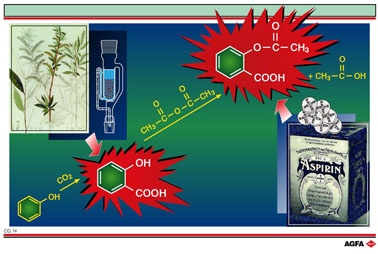CG14 Aspirin: from willow bark to painkiller
| Aim:
To demonstrate that "natural" painkillers can be improved
by chemical modification. |
The
history of aspirin dates back to the Ancient Greek civilisation: Hippocrates
had described a brew of willow bark (Salix Alba) that helped fevers and
pain during childbirth.
The active ingredient, salicylic acid, was however only in 1865 extracted
from plant material by the German chemist Jakob Löwig.
Salicylic acid is nowadays manufactured using the Kolbe synthesis, by
the reaction of phenol with carbon dioxide under basic conditions.
However, salicylic acid exhibited a number of negative side effects such
as irritation of the mouth, stomach and intestines.
A solution to this was found by synthesis of certain chemical analogues.
A useful method was developed by Felix Hoffman of Farben-Fabriken Bayer
and Co. In 1899 they, together with Heinrich Dreser, patented their product
aspirin, or acetylsalicylic acid. This had been prepared by the reaction
of salicylic acid with acetic acid anhydride.
